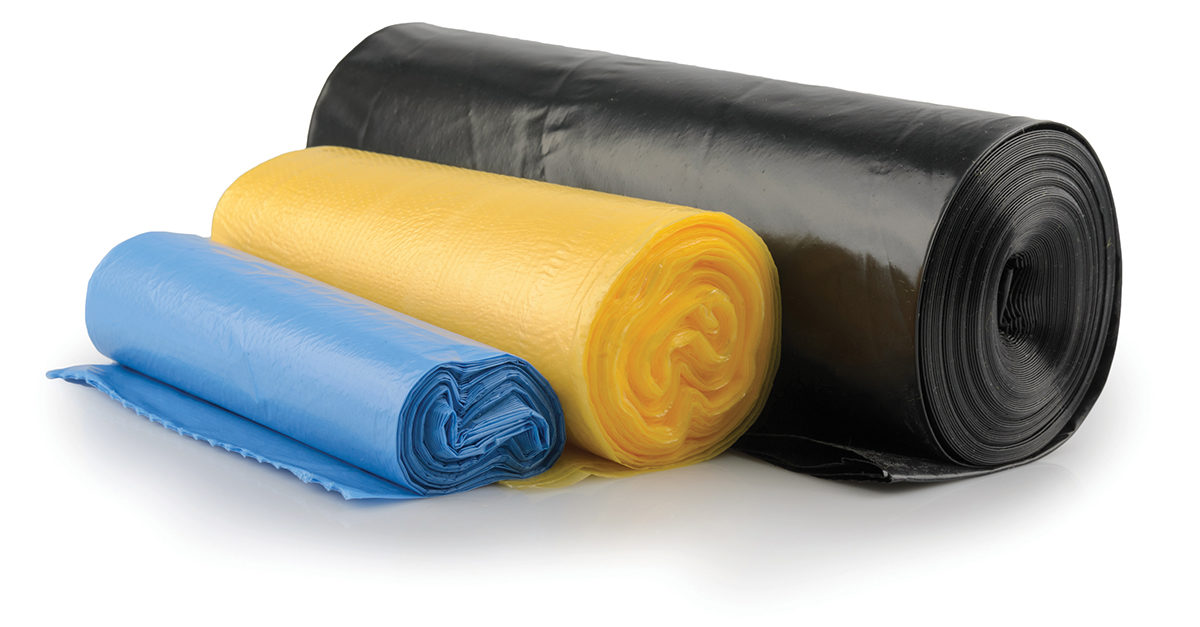Vital for sanitation and maintenance, can liners are a necessary spend for businesses and institutions. While they may seem to be simple everyday items, it’s easy to overlook the opportunities they offer for substantial cost savings and improved sustainability practices.
There are numerous ways to get more value from can liner expenditures and generate less waste without sacrificing quality. These methods include:
- Using can liners with fewer raw materials and recycled resins
- Conducting can liner audits
- Using can liners of the right size and strength for the job.
Can Liner Manufacturing
It is important to realize that every can liner begins as raw material, or resin. Raw material costs are a key factor in the price of every can liner, large or small, heavy duty or not. Resin technology has changed throughout the years, and for some time now, thickness is no longer the key indicator of a can liner’s strength. That is why is it best to refer to the can liner performance and load capacity specifications when making purchasing decisions.
Most can liners are manufactured using either linear low-density or high-density blown polyethylene film. These names can be a bit confusing, as linear low-density is often produced at heavier gauges and often has a thicker feel. Linear low-density can liners are best for waste that may contain sharp objects, as they are less susceptible to tearing if an item punctures them. A high-density can liner is often thinner in gauge and feel, as this type of film can hold more weight at thinner gauges and is a good choice for light, medium, or heavy waste without sharp objects.
Can Liner Audits
A can liner audit is a must for customers that use a large quantity of liners on an annual basis. A good can liner audit conducted by a knowledgeable person who is equipped with the right information and tools will ensure the facility is using the right size bag in addition to the right strength and material. This is where savings can really add up.
The health care industry is a great example of a marketplace that can benefit from can liner audits, as it has experienced a lot of merger and acquisition activity. For instance, instead of efficiently buying five or six different bags for a hospital group, the purchasing agent may be buying 20 different bags just to keep everyone happy. Maybe they don’t want to change the status quo, or a particular person prefers a certain liner.
Size and Strength
Consider a can liner in a large restroom at an airport or public school. The custodian may be using a heavy-duty liner that is meant to hold 70 pounds, while in reality the liner is only going to contain light waste, such as paper towels and tissue, and doesn’t need to hold any more than 20 pounds. Most of the resin that was used to manufacture that heavy-duty liner will go to waste and so will part of the money spent for that liner.
Slim 23-gallon and 44-gallon round cans are two of the most popular waste receptacle sizes today. It may seem easier for maintenance staff to use the same size bag for both and just tie off the bigger bag to make it fit the smaller receptacle. However, when that is done, more than 40 percent of the resin in the can liner goes to waste. There is no reason for any can liner to hang more than four to six inches—tops—over the rim of a receptacle.
With today’s global economy, it is also important to check out what you are actually buying. If the price seems too good to be true, be aware that super cheap can liners from disreputable sources may not meet the specs on the packaging. The gauge may be a bit lighter than represented, or the product count may be a few pieces lower than represented. That adds up over time.
LEEDing to Sustainability
An ever-growing number of businesses, universities, schools, restaurants, hospitals, and government buildings are participating in green building maintenance and operation programs that are endorsed by the U.S. Environmental Protection Agency (EPA), such as Leadership in Energy and Environmental Design (LEED). The EPA provides Comprehensive Procurement Guidelines for Janitorial Paper and Plastic trash can liners.
Documented purchase and use of sustainable products is a key aspect of obtaining credits for LEED certification. In October 2016, LEED Version 4 will go into effect, and requirements for the purchase of sustainable paper and plastics items, such as can liners, will increase.
In order for a can liner to contribute to LEED credits, it must contain a minimum of 10 percent or more post-consumer content, i.e. resin. Post-consumer resin is created from plastic material that has completed life as a consumer item and been removed from the waste stream.
Post-industrial resin is used for recycled can liners, as well. Post-industrial resin is material, such as scrap, from the manufacturing process that is diverted from the waste stream. It is an important part of recycling, but use of post-industrial recycled material does not qualify can liners for LEED.
The interest in recycled can liners that contain post-consumer content continues to grow. However, this is challenging for the industry because not all plastic is usable for can liners. The post-consumer material requires a certain type of polyethylene film in its former use—such as dry cleaning bags, merchandise bags, food wrap, etc. It has to be sourced, collected, cleaned, and processed.
Long-term Waste Management
Without question, can liners are necessary products that deserve a second look. Cost savings and ways to improve sustainability practices are in the marketplace for any business or institution that wants to take advantage of them.
Choosing the Right Can Liner
- Determine the proper liner type. If sharp objects are being thrown away, linear low-density can liners are recommended. If not, choose high-density can liners.
- Determine the size of the container the liner needs to fit. Overhang shouldn’t exceed four to six inches; anything more wastes material and money.
- Determine the weight of a full can liner in your environment. Then, refer to the capacity charts in the product catalog or spec sheet.



